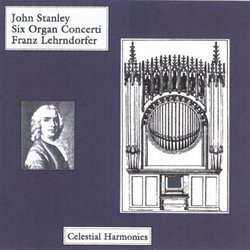| All Artists: Franz Lehrndorfer Title: John Stanley: Six Organ Concertos op. 10 Members Wishing: 0 Total Copies: 0 Label: Celestial Harmonies Release Date: 1/1/2004 Genre: Classical Styles: Chamber Music, Forms & Genres, Concertos, Historical Periods, Baroque (c.1600-1750), Classical (c.1770-1830) Number of Discs: 1 SwapaCD Credits: 1 UPC: 013711323429 |
Search - Franz Lehrndorfer :: John Stanley: Six Organ Concertos op. 10
 | Franz Lehrndorfer John Stanley: Six Organ Concertos op. 10 Genre: Classical
Despite losing his sight in an accident at age two, John Stanley (1712-1786) was equally successful as a violinist, a conductor and a teacher. Reportedly he could conduct a work from memory after just one hearing. In th... more » |
Larger Image |
CD Details
Synopsis
Album Description
Despite losing his sight in an accident at age two, John Stanley (1712-1786) was equally successful as a violinist, a conductor and a teacher. Reportedly he could conduct a work from memory after just one hearing. In the course of his lifetime he composed songs, ballads, concertos, cantatas, oratorios and stage works. Stanley's six Concertos span the years 1740 to 1775, and reflect the stylistic development that Stanley, a contemporary of Handel, Bach and Mozart, experienced. Franz Lehrndorfer worked on Stanley's Concertos Op. 10 from 1997 to 2000, on the basis of a facsimile edition published by Oxford University Press. They were scored for `two violins and a bass' (cello and double bass), omitting any wind instruments, and even the viola. The solo instrument, which according to the title, can be `Organ, Harpsichord or Forte Piano', is therefore especially important. It is an interesting challenge to translate a fairly thin, three-part score on to the organ, both respecting the original composition and utilizing the possibilities of the organ, as the same notes can have varying effects on different instruments. A further peculiarity of these Concertos is the omission, in four of them, of a slow movement, which the performer was expected to insert according to the circumstances. Lehrndorfer opted to complete the four Concertos by inserting some of Stanley's Voluntaries. The Concertos are played on the magnificent organ of the Munich Frauenkirche. It offers a multitude of tonal possibilites, of which only a small part are suitable when performing Stanley. The recording therefore only uses the main organ and only a small part of the possible registrations. In summary, this recording can be described as a deeply personal, but nevertheless authentic interpretation of Stanley's Organ Concertos, that would have surely received the acclaim of the composer.

 Track Listings (19) - Disc #1
Track Listings (19) - Disc #1